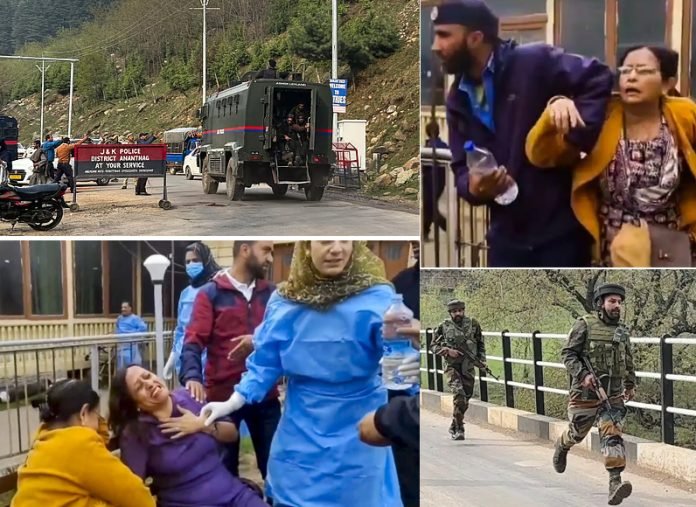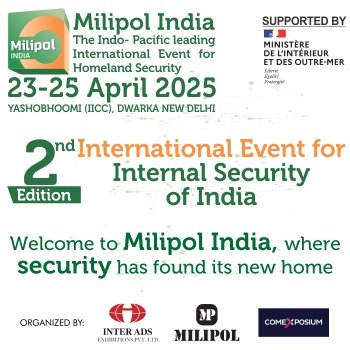Tuesday’s terrorist attack in Pahalgam, Kashmir, is a clear reminder that the region remains under constant threat from the forces that seek to cause instability in India. It is not just an attack on innocent civilians; it is a calculated manoeuvre meant to destabilise India’s position on the global stage, especially during high-profile diplomatic moments. This assault demands not only an appropriate strategic response but also a paradigm shift in how India responds to proxy wars, such as the one being waged by Pakistan in Kashmir.
Pattern of Attacks: A Repeat of the Past
Historically, terror attacks in Kashmir have been closely timed with diplomatic events that involve global stakeholders, particularly the United States. This has been seen in the past with events such as the Chattisinghpura massacre (2000), the Kaluchak attack (2002), and the devastating Pulwama attack (2019). The Pahalgam attack follows this troubling pattern and should be considered part of Pakistan’s broader strategy of using terror to disrupt India’s peace and its international relations.
What is increasingly evident is that these attacks are not mere coincidences but are strategically aimed at weakening India’s resolve and portraying the Kashmir issue as an intractable conflict. The timing of these attacks, while they do cause immense grief, also reflects the growing complexity of the region’s security dynamics and the need for India to think beyond tactical responses.
Lack of Intelligence a Concern
Pahalgam, a popular tourist destination, is not a remote frontier but a well-travelled area with a constant flow of tourists and security personnel. The fact that terrorists were able to execute an attack so close to high-traffic areas raises troubling questions about the gaps in intelligence and operational preparedness. Geography is well known and thus should have been dovetailed in threat analysis. Local intelligence also failed.
While it is easier said than done in a counter-terrorist environment, such a surprise attack at known soft target locations raises many issues. The coordination between various agencies, including local police, central forces, and the military, must be reassessed to better anticipate and respond to such threats. Further, the failure of local intelligence to realise the presence of terrorists is worrisome. Without a more robust intelligence framework, future attacks will continue to exploit these gaps. Pahalgam terror attacks have many lessons which must not be brushed aside.
Simultaneously, it’s time to introspect dispassionately how it happened under our eyes at a place known to be a soft target. Did complacency set in? Accountability must be established.
Terror attacks in Kashmir have been closely timed with diplomatic events that involved global stakeholders, particularly the United States. The Pahalgam attack follows this troubling pattern and should be seen as part of Pakistan’s broader strategy of using terrorism to disrupt India’s peace and international ties
Urgent Paradigm Shift in Proxy War Strategy
The response to such attacks requires more than just retribution — it requires a comprehensive strategic overhaul. The phrase “Hit Hard- Hit Where It Hurts- Hurt Where It Lasts” encapsulates the essence of the response strategy needed. India’s military and diplomatic responses should be synergised, employing all elements of national power, from military force to economic sanctions, to create an enduring deterrence against Pakistan’s proxy war tactics.
India’s prior responses, such as the surgical strikes post-Uri, have been tactical, aimed at sending a strong message. However, these actions have failed to communicate India’s true deterrent capability or resolve at a strategic level. What is now needed is a shift towards a strategy of coercive diplomacy — one that combines political isolation, economic sanctions, and military compellence. This strategy must aim to inflict long-lasting out-of-proportion damage on Pakistan’s will to continue its support to terrorism.
Hit Hard: The Need for Military Compellence
A strategic shift must begin with military compellence. Surgical strikes, while necessary at times, must no longer be viewed as the primary tool. The objective should be to pre-emptively dismantle Pakistan’s terrorist infrastructure within Kashmir and beyond, targeting its leadership and logistical networks. The concept of military compellence aims at achieving not only the immediate tactical gains, but also sending a decisive message that India can strike when and where it chooses.
The scope of military responses must include not just overt actions but also covert operations that target Pakistan’s ‘strategic assets’, such as its terror networks such as Lashkar-e-Taiba (LeT) and Jaish-e-Mohammad (JeM). Additionally, eliminating internal support structures within India that enable these terrorists — whether through financial or ideological support — is crucial to denying Pakistan space to operate.
India must move beyond reactionary policies, petty politics, pseudo nationalism and shift to a holistic, proactive strategy. The coordination between the various agencies, including local police, central forces, and the military, must be reassessed to anticipate terror threats and respond accordingly
Hit Where it Hurts: Exploiting Pakistan’s Vulnerabilities
Pakistan’s strategic culture, rooted in insecurity, fragile economic stability, and a revisionist foreign policy, presents numerous vulnerabilities that should be exploited. These vulnerabilities lie not only in Pakistan’s economic and military domains but also in internal instability. By targeting Pakistan’s economic chokepoints — through sanctions and global diplomatic pressure — India can cripple Pakistan’s ability to sustain its military and intelligence operations that perpetuate the proxy war.
The diplomatic strategy must focus on isolating Pakistan internationally, branding it unequivocally as a state sponsor of terrorism. India’s foreign policy must aim to gather global support to impose sanctions and increase international pressure on Pakistan. The ultimate goal should be to raise the costs for Pakistan’s deep state, making the pursuit of proxy warfare prohibitively expensive and strategically unsustainable.
All options should be analysed and one or a combination of the available alternatives be exercised. Apart from Military punitive response on terror establishments, flaring up of LoC, abrogation of the IWT, support to the Baluch uprising, Pashtuns and covert action against terror leadership, including the ISI, must be explored.
Diplomatic isolation of Pakistan by the international community needs to be raised and encouraged. FATF must also be sensitised to put them in black list. Economically put in place sanctions that hurt them along with politically aggressive action beyond isolation. All fault lines of Pakistan must be utilised with sustainable intensity.
Hurt Where It Lasts: Sustained Pressure and Long-Term Impact
To ensure that the message is not only heard but felt, India must adopt a strategy of sustained military pressure. The effectiveness of this approach lies not just in the immediate retaliation but in maintaining a steady tempo of operations. Such actions would create a long-lasting psychological and physical toll on Pakistan’s military leadership and its proxies.
The ultimate objective should be to create an environment where Pakistan’s decision-makers are forced to reconsider the strategic cost of their actions. Full-scale war should always remain a last resort; however, a well-executed sub-conventional military strategy, backed by covert and overt operations, will send a clear signal of India’s resolve. This must be complemented by diplomatic and economic measures that systematically weaken Pakistan’s standing and its ability to support terrorism.
India’s diplomatic strategy must focus on isolating Pakistan internationally, branding it unequivocally as a state sponsor of terrorism. India’s foreign policy must aim to gather global support to impose sanctions and increase international pressure on Pakistan. Full-scale war should remain a last resort
A Comprehensive Response Strategy: All Elements of National Power
India must move beyond reactionary policies, petty politics, pseudo nationalism and shift to a holistic, proactive strategy. “Hit Hard- Hit Where It Hurts- Hurt Where It Lasts” is not just a military mantra but a call for integrating all instruments of national power. The response should involve:
- Military: Pre-emptive and targeted strikes against terrorist infrastructure, leadership, and support networks. Escalate the borders and let Pakistan feel the heat. It already has its handful on the Afghan border and in Baluchistan.
- Diplomatic: Isolating Pakistan globally, pushing for sanctions, and building a coalition of nations committed to countering its support of terrorism.
- Economic: Using sanctions and economic leverage to pressure Pakistan’s military and civilian leadership.
- Internal Security: A zero-tolerance approach to internal collaborators and sympathisers, dismantling any support infrastructure within India.
Conclusion: A New Era of Strategic Response
The Pahalgam attack must be the turning point. India can no longer afford to play defensive or reactive; it must lead with strength, decisiveness, and a coherent strategy that uses all levers of national power with a pre-emptive and proactive approach. The paradigm shift proposed is critical: moving from tactical responses to a strategy of coercive diplomacy and sustained military pressure, designed to cripple Pakistan’s ability and will to wage proxy war.
India’s response to terror should not be limited to short-term reprisals but must aim to fundamentally alter the cost-benefit calculus for Pakistan. This is a time to act decisively, with clarity, purpose, and unwavering commitment to national sovereignty.
The author, a PVSM, AVSM, VSM has had an illustrious career spanning nearly four decades. A distinguished Armoured Corps officer, he has served in various prestigious staff and command appointments including Commander Independent Armoured Brigade, ADG PP, GOC Armoured Division and GOC Strike 1. The officer retired as DG Mechanised Forces in December 2017 during which he was the architect to initiate process for reintroduction of Light Tank and Chairman on the study on C5ISR for Indian Army. Subsequently he was Consultant MoD/OFB from 2018 to 2020. He is also a reputed defence analyst, a motivational speaker and prolific writer on matters of military, defence technology and national security. The views expressed are personal and do not necessarily carry the views of Raksha Anirveda

















